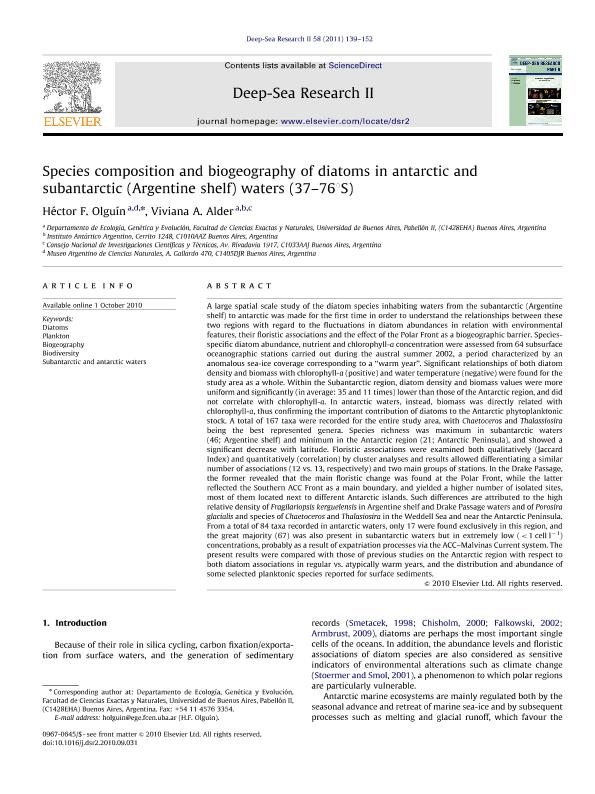Mostrar el registro sencillo del ítem
dc.contributor.author
Olguin Salinas, Hector

dc.contributor.author
Alder, Viviana Andrea

dc.date.available
2023-02-27T11:17:07Z
dc.date.issued
2011-01
dc.identifier.citation
Olguin Salinas, Hector; Alder, Viviana Andrea; Species composition and biogeography of diatoms in antarctic and subantarctic (Argentine shelf) waters (37-76°S); Pergamon-Elsevier Science Ltd; Deep Sea Research Part II: Topical Studies in Oceanography; 58; 1-2; 1-2011; 139-152
dc.identifier.issn
0967-0645
dc.identifier.uri
http://hdl.handle.net/11336/188912
dc.description.abstract
A large spatial scale study of the diatom species inhabiting waters from the subantarctic (Argentine shelf) to antarctic was made for the first time in order to understand the relationships between these two regions with regard to the fluctuations in diatom abundances in relation with environmental features, their floristic associations and the effect of the Polar Front as a biogeographic barrier. Species-specific diatom abundance, nutrient and chlorophyll-a concentration were assessed from 64 subsurface oceanographic stations carried out during the austral summer 2002, a period characterized by an anomalous sea-ice coverage corresponding to a "warm year". Significant relationships of both diatom density and biomass with chlorophyll-a (positive) and water temperature (negative) were found for the study area as a whole. Within the Subantarctic region, diatom density and biomass values were more uniform and significantly (in average: 35 and 11 times) lower than those of the Antarctic region, and did not correlate with chlorophyll-a. In antarctic waters, instead, biomass was directly related with chlorophyll-a, thus confirming the important contribution of diatoms to the Antarctic phytoplanktonic stock. A total of 167 taxa were recorded for the entire study area, with Chaetoceros and Thalassiosira being the best represented genera. Species richness was maximum in subantarctic waters (46; Argentine shelf) and minimum in the Antarctic region (21; Antarctic Peninsula), and showed a significant decrease with latitude. Floristic associations were examined both qualitatively (Jaccard Index) and quantitatively (correlation) by cluster analyses and results allowed differentiating a similar number of associations (12 vs. 13, respectively) and two main groups of stations. In the Drake Passage, the former revealed that the main floristic change was found at the Polar Front, while the latter reflected the Southern ACC Front as a main boundary, and yielded a higher number of isolated sites, most of them located next to different Antarctic islands. Such differences are attributed to the high relative density of Fragilariopsis kerguelensis in Argentine shelf and Drake Passage waters and of Porosira glacialis and species of Chaetoceros and Thalasiosira in the Weddell Sea and near the Antarctic Peninsula. From a total of 84 taxa recorded in antarctic waters, only 17 were found exclusively in this region, and the great majority (67) was also present in subantarctic waters but in extremely low (<1celll-1) concentrations, probably as a result of expatriation processes via the ACC-Malvinas Current system. The present results were compared with those of previous studies on the Antarctic region with respect to both diatom associations in regular vs. atypically warm years, and the distribution and abundance of some selected planktonic species reported for surface sediments.
dc.format
application/pdf
dc.language.iso
eng
dc.publisher
Pergamon-Elsevier Science Ltd

dc.rights
info:eu-repo/semantics/openAccess
dc.rights.uri
https://creativecommons.org/licenses/by-nc-sa/2.5/ar/
dc.subject
BIODIVERSITY
dc.subject
BIOGEOGRAPHY
dc.subject
DIATOMS
dc.subject
PLANKTON
dc.subject
SUBANTARCTIC AND ANTARCTIC WATERS
dc.subject.classification
Ecología

dc.subject.classification
Ciencias Biológicas

dc.subject.classification
CIENCIAS NATURALES Y EXACTAS

dc.subject.classification
Biología Marina, Limnología

dc.subject.classification
Ciencias Biológicas

dc.subject.classification
CIENCIAS NATURALES Y EXACTAS

dc.subject.classification
Ciencias de las Plantas, Botánica

dc.subject.classification
Ciencias Biológicas

dc.subject.classification
CIENCIAS NATURALES Y EXACTAS

dc.title
Species composition and biogeography of diatoms in antarctic and subantarctic (Argentine shelf) waters (37-76°S)
dc.type
info:eu-repo/semantics/article
dc.type
info:ar-repo/semantics/artículo
dc.type
info:eu-repo/semantics/publishedVersion
dc.date.updated
2023-02-21T22:16:20Z
dc.journal.volume
58
dc.journal.number
1-2
dc.journal.pagination
139-152
dc.journal.pais
Estados Unidos

dc.description.fil
Fil: Olguin Salinas, Hector. Universidad de Buenos Aires. Facultad de Cs.exactas y Naturales. Departamento de Ecología, Genética y Evolución. Laboratorio de Ecología Marina Microbiana; Argentina. Consejo Nacional de Investigaciones Científicas y Técnicas. Oficina de Coordinación Administrativa Parque Centenario. Museo Argentino de Ciencias Naturales "Bernardino Rivadavia"; Argentina
dc.description.fil
Fil: Alder, Viviana Andrea. Universidad de Buenos Aires. Facultad de Cs.exactas y Naturales. Departamento de Ecología, Genética y Evolución. Laboratorio de Ecología Marina Microbiana; Argentina. Ministerio de Relaciones Exteriores, Comercio Interno y Culto. Dirección Nacional del Antártico. Instituto Antártico Argentino; Argentina. Consejo Nacional de Investigaciones Científicas y Técnicas; Argentina
dc.journal.title
Deep Sea Research Part II: Topical Studies in Oceanography

dc.relation.alternativeid
info:eu-repo/semantics/altIdentifier/url/https://www.sciencedirect.com/science/article/abs/pii/S096706451000278X
dc.relation.alternativeid
info:eu-repo/semantics/altIdentifier/doi/http://dx.doi.org/10.1016/j.dsr2.2010.09.031
Archivos asociados
